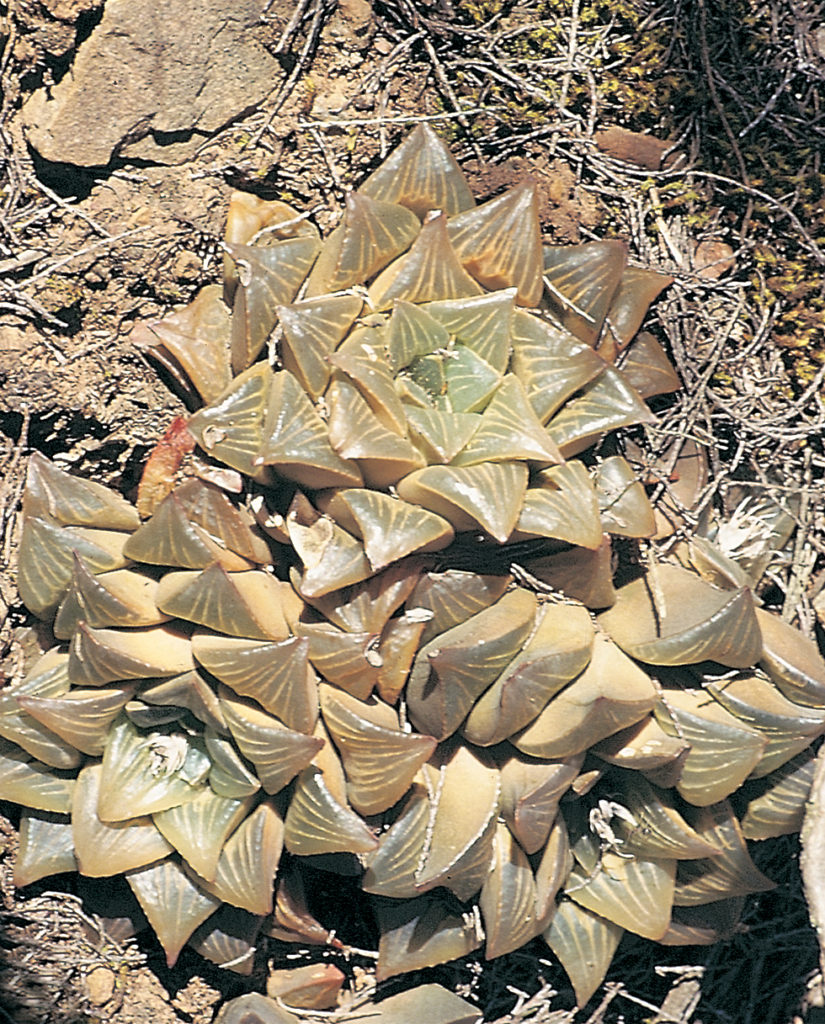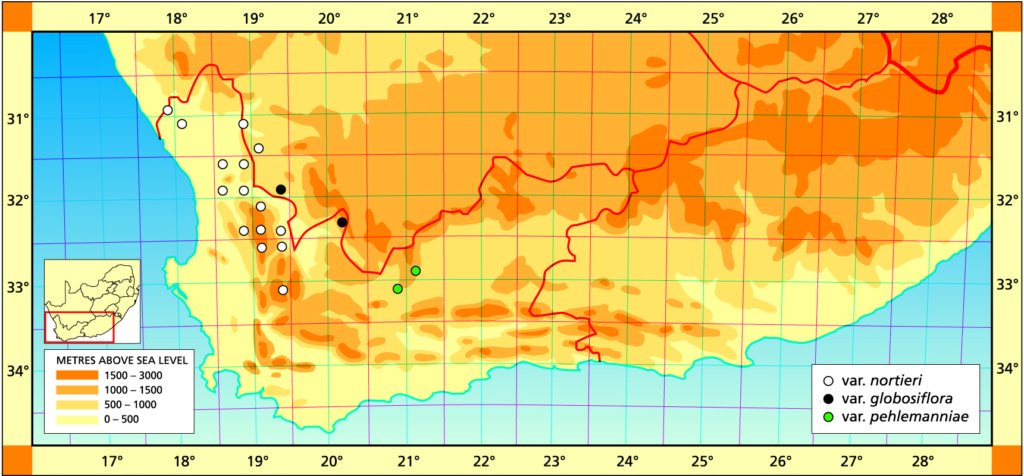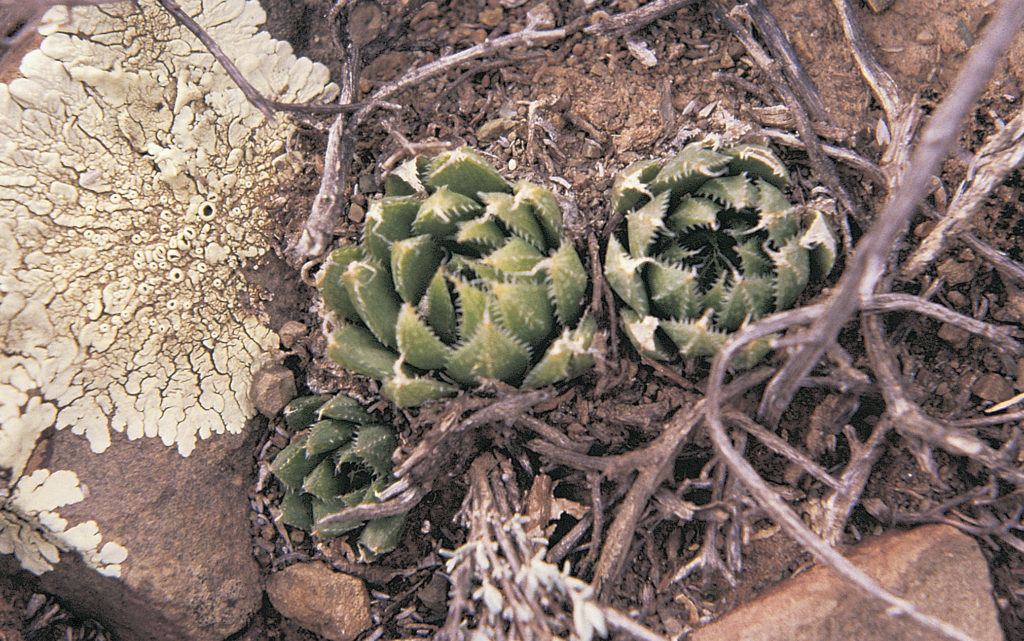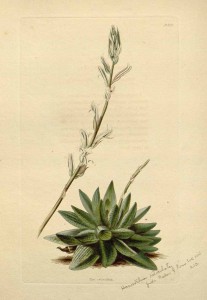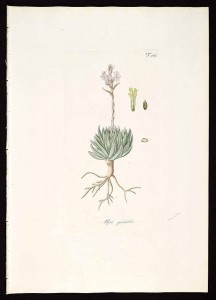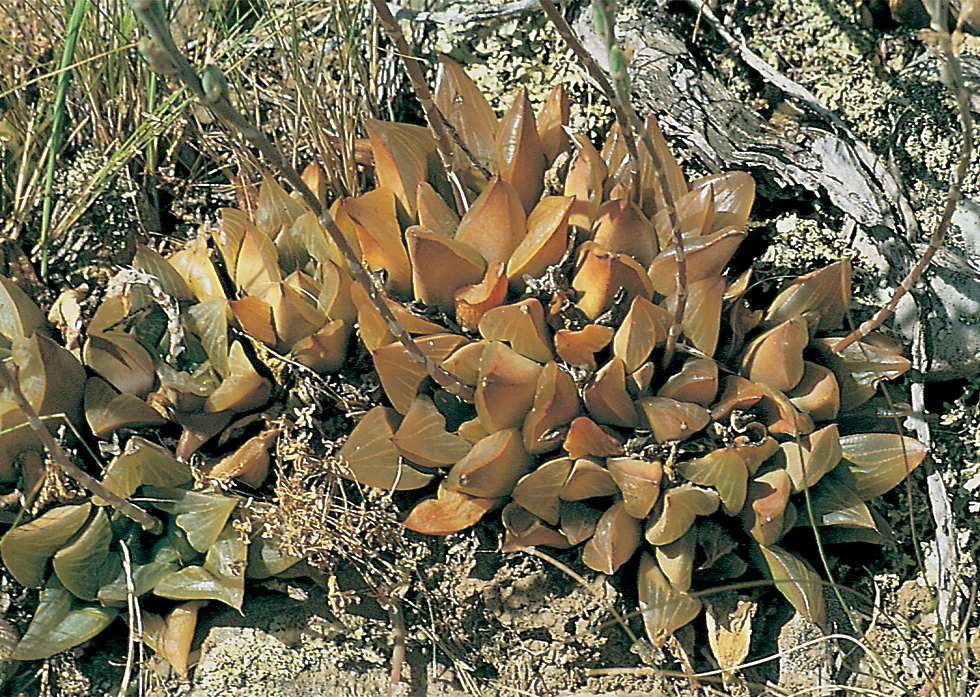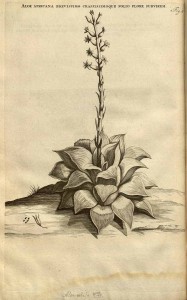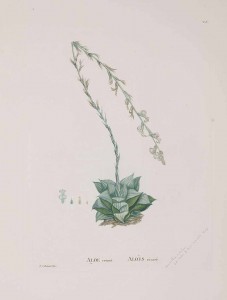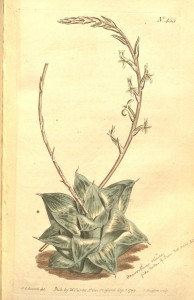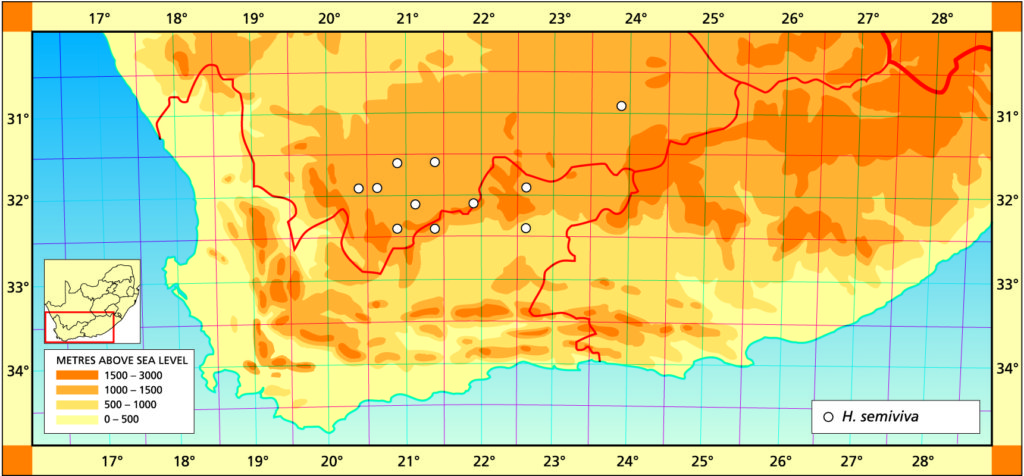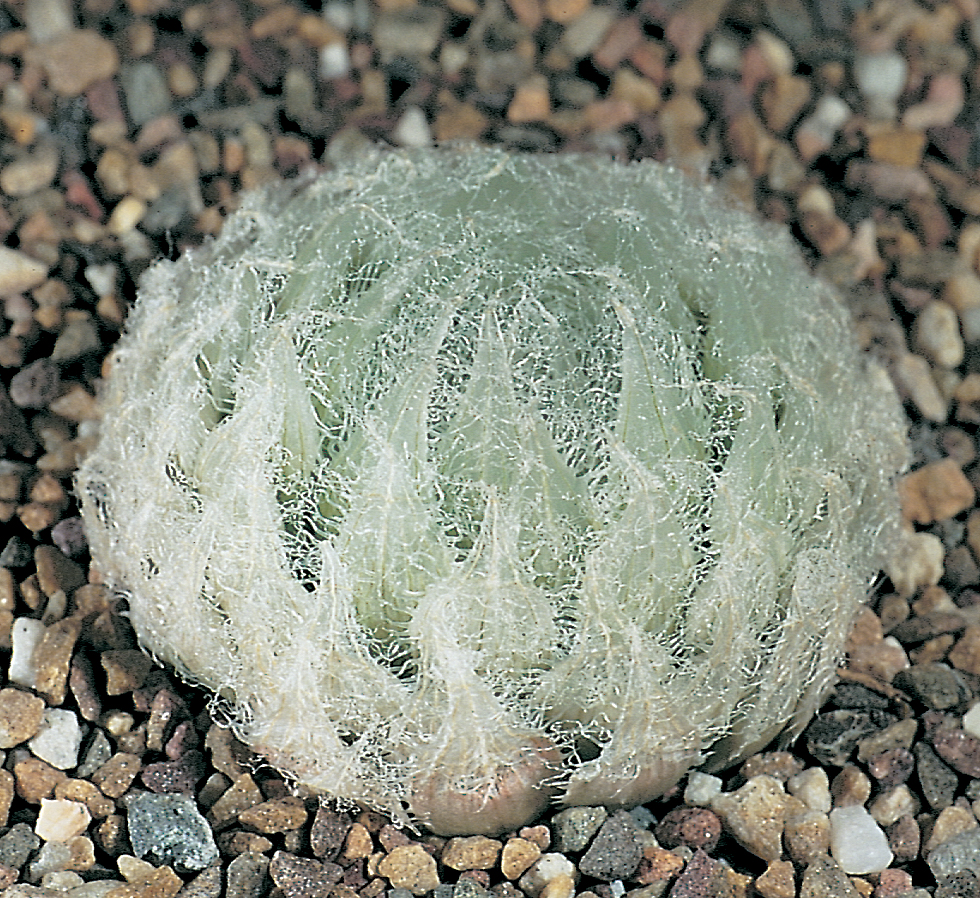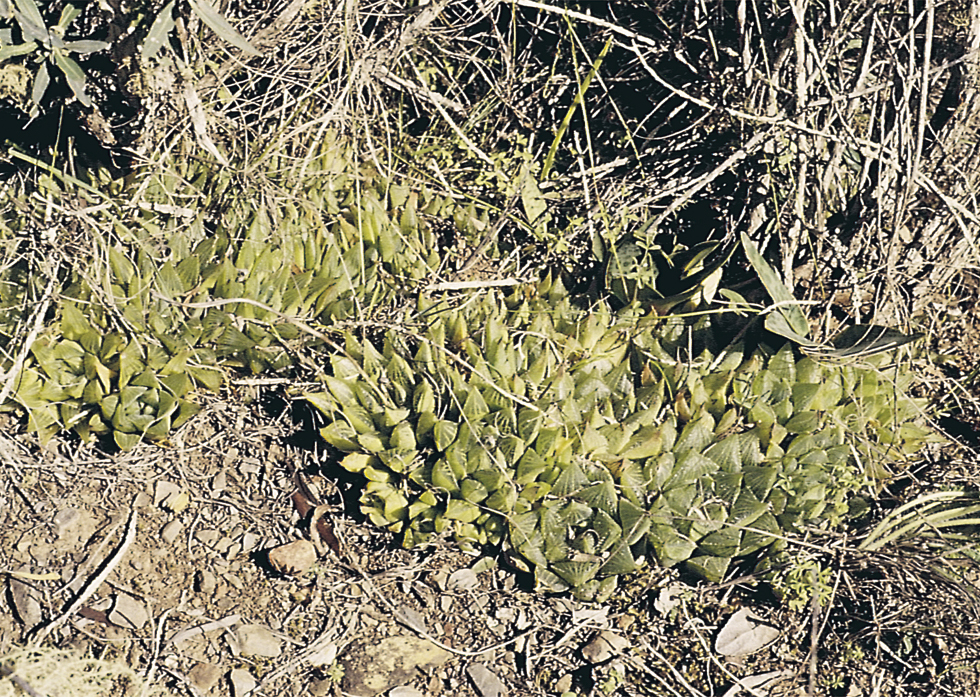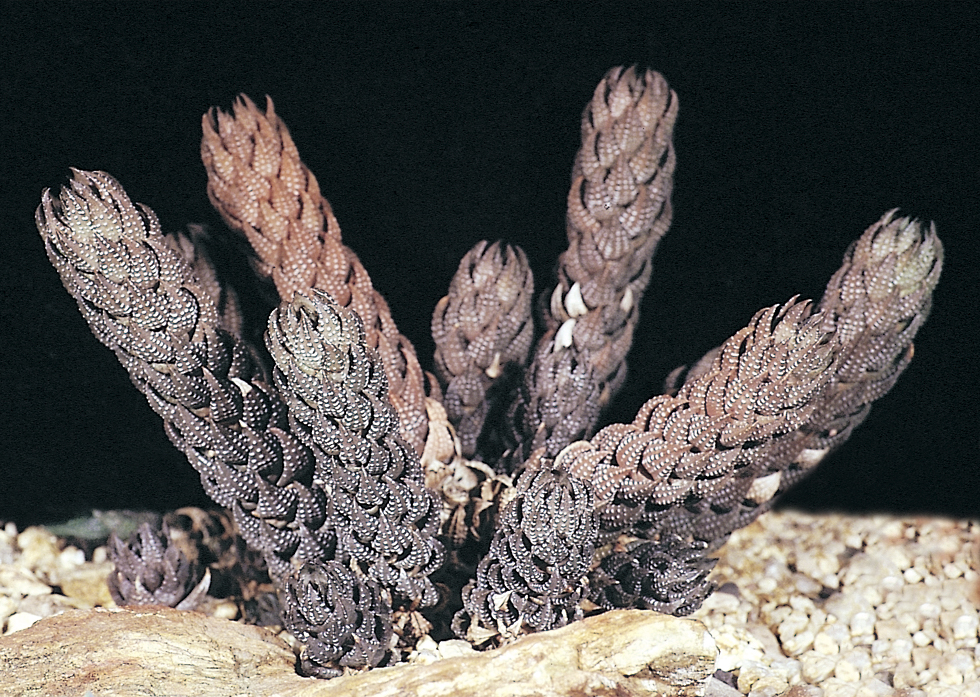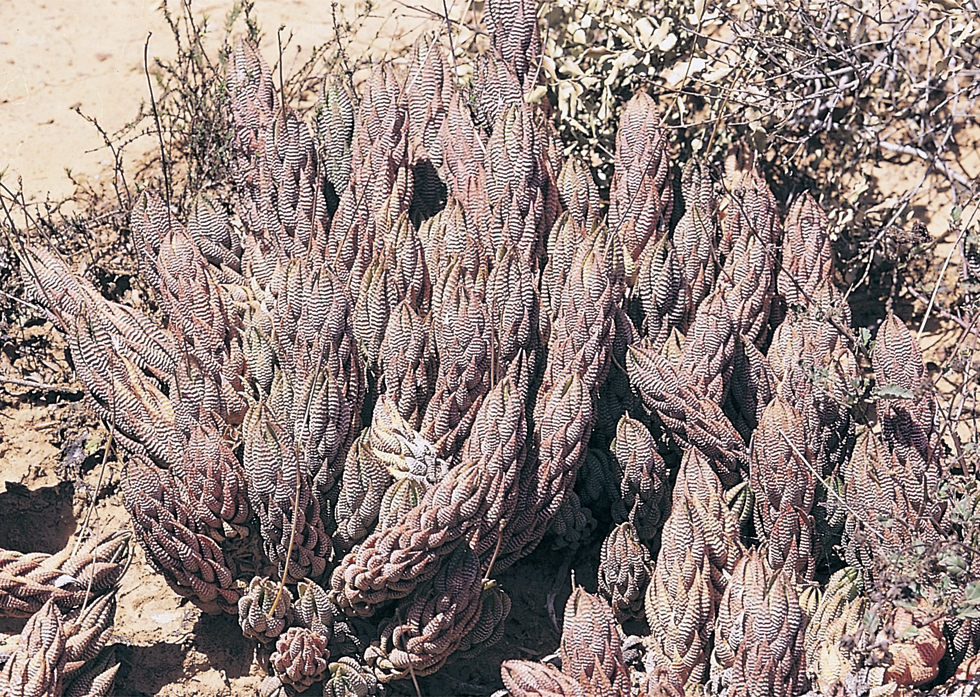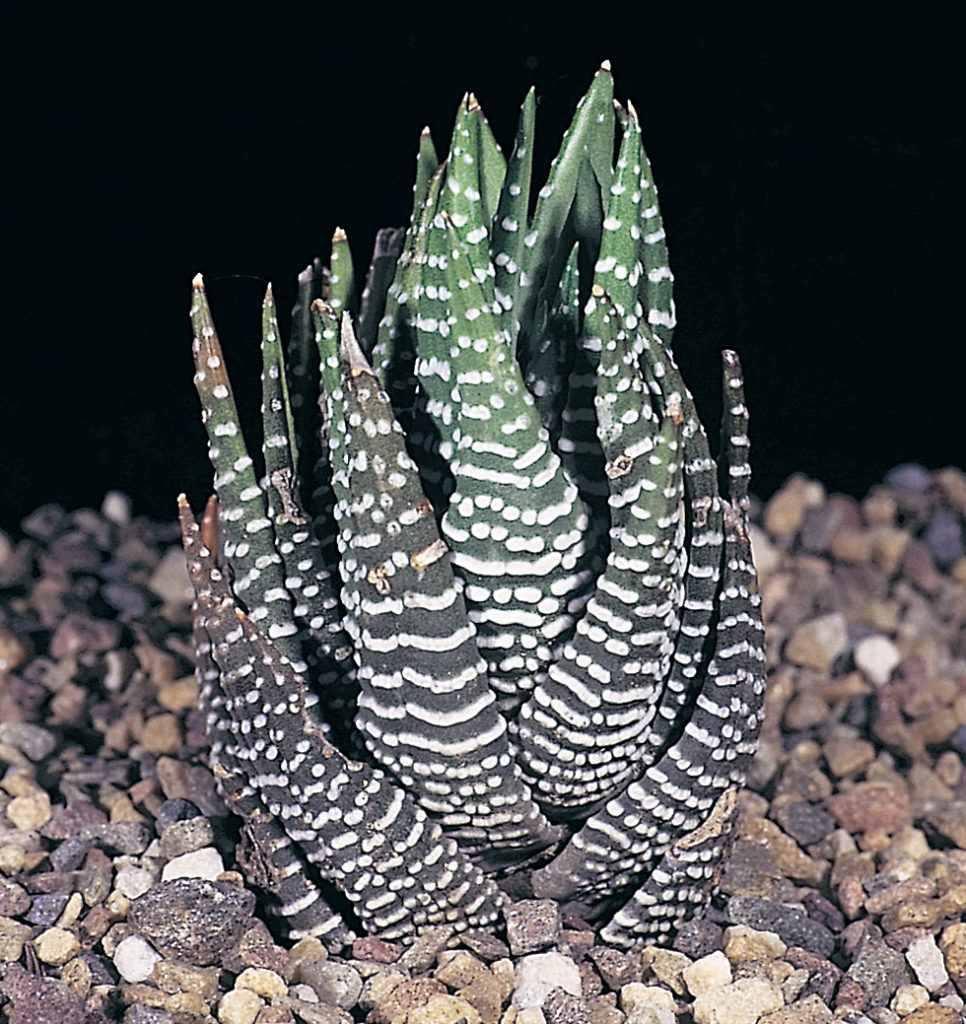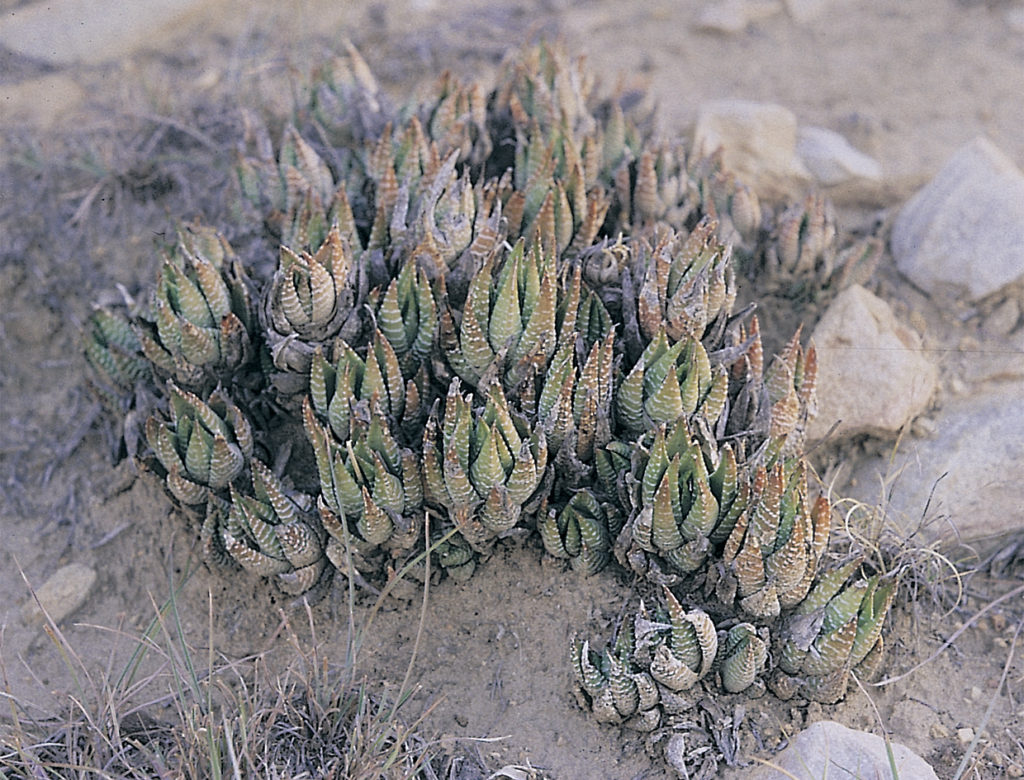23. Haworthia mucronata Haw., Haworth, Suppl .. Pl. Succ.: 50 (1819). Type: Cape, exhort. Kew. Not preserved. Lectotype: icon (K): H. helmiae V.Poelln., Feddes Repert. Spec. Nov. 41: 201 (1937). Scott: 99 (1985). H. unicolorvar. helmiae (V.Poelln.) M.B.Bayer: 121 (1976), Bayer: 59(1982): Type: Cape, Heidelberg, Smithers in Triebn. 901, Gt Brak River, Mrs Helm in Triebn. 901. Not preserved . Lectotype (B&M): icon, (B). Epitype (designated here): CAPE-3322 (Oudtshoorn): Schoemanspoort (-AC), Bayer 171 (NBG): H. V. Poelln., Feddes Repert. Spec. Nov. 44: 233 (1938), Scott: 98 (1985). Type: Cape, Little Karoo, Mrs E. Ferguson. Not preserved. Neotype (designated here): CAPE-3321 (Calitzdorp): On the Gamka East road (-DA), Scott 1050 (PRE): H unicolorV.Poelln., Kakteenkunde 10: 133 (icon), 154 (1937). Bayer: 165 (1976). H. unicolor var. unicolor (V.Poelln .) M.B.Bayer: 59 (1982): Type: Cape, Barrydale, A.J. Joubert in STE5230. Not preserved. Lectotype (B&M): icon in Kakteenk. & Kakteenfr.: 133 (1937): Epitype (designated here): CAPE-3320 (Montagu): Barrydale (-DC), J. Dekenah 234 (NBG): H. mclarenii V.Poelln., Des. Pl. Life 11: 107 (1939). Type: Cape, near Barrydale, G. McLaren in Triebn. 1160. Not preserved. Lectotype (B&M): icon (B): H. aristata Haw. sensu. V.Poelln., Feddes Repert. Spec. Nov. 43: 92 (1938). Ibid. 49: 27 (1940). Sensu Jacobsen 2: 537 (1954). Sensu CL.Scott, Nat. Cact. Succ. J. 35: 11 (1980). Ibid.: 110 (1937): H. serrata M.B.Bayer sensu CL.Scott: 62 (1985).
mucronata: pointed.
Rosette stemless, proliferous, 6-12cm φ. Leaves 30-45, soft, incurved, broadly ovate-lanceolate, slightly pellucid, with translucent margins and keel, both often spined. Inflorescence simple, robust. Flowers many, compact on peduncle, broad across upper tube, white with green venation.
NOTE: Considerable confusion surrounds the above and following synonymies. The species H. unicolor and H. rycroftiana are now included here, and one variety of the former, var. venteri, is transferred to H. arachnoidea. Haworthia habdomadis and its varieties are also subsumed in this new arrangement, under H. mucronata.
1982 – The original specimen of H. unicolor was from the town of Barrydale and pale green plants of this kind can still be found in that immediate area. However, von Poellnitz also included citations from Montagu and Ockertskraal. In a later publication (1938), he included the species in synonymy under H. aristata on the basis of plants received from Long from the Cango Caves. These plants included forms which von Poellnitz felt represented both his H. unicolor and H. aristata. However, in Feddes Repert. Spec. Nov. 43:92(1940), he continues the discussion and cites specimens, one later to be described as H. mclarenii. It seems clear that these citations by vn Poellnitz refer to the better known and highly variable H. unicolor var. venteri. The locality of H. mclarenii cited by Von Poellnitz as Tulbagh was patently erroneous. G.G. Smith records that W.E. Armstrong wrote “I had sent away a batch of plants, some from Mr McLaren and others from Miss de Klerk of Tulbagh and of the batch L693, Arm. 180 and Trieb.1160 actually collected by Miss de Klerk of Uitzicht, P.O. Tulbagh, at Barrydale, was erroneously named H. mclarenii”. There is thus no doubt that this species is synonymous with H. unicolor. A photograph by Fourcade (no.224) of H. mclarenii also confirms this view. The type locality for H. venteri was recorded by Smith as ” 3/4m. Barrydale‑Lemoenshoek” although Major H. Venter’s localities are very broadly stated in publication and practically valueless. Only Smith’s notes give any better clue to these but in this case there is still no certainty. However, there is a very common species extending from Barrydale to Oudtshoorn from which this variety is clearly drawn. At Barrydale itself the plants are rather pale green with elongated sparsely setate leaves ‑ this is regarded here as the species H. unicolor. Eastward the plants are more robust and often glabrous, usually distinguished by particularly dark‑purplish coloration towards the leaf tips. The further eastward one progresses the more setate the plants become until at Oudtshoorn, south of the Cango Caves, the plants are comparatively small and more softly setate (H. unicolor var.helmiae). It is not in the least clear what the relationship is between H. unicolor and H. arachnoidea. They do not appear to cohabit which suggests that they may be conspecific and only differentiated on an ecotypic basis. This is borne out by the pale arachnoidea‑like population at the northern entrance to the Tradouw Pass, south of Barrydale. However at Ladismith H. arachnoidea is present as a very distinct heavily setate form, and similarly south of the Cango Caves it occurs near to H. unicolor var. helmiae as a softer haired but also highly setate form. Cognisance must also be taken of H. integra from apparently west of Ladismith. The species H. unicolor is therefore not well‑known or properly understood and this solution must be regarded as suspect. Von Poellnitz’s citations of localities for the var. helmiae are highly confusing and in Feddes Repert. Spec. Nov. 44:223(1938) are totally disparate. The type is cited in 1938 as “Great Brak River, Mrs Helm” and three Triebner numbers are added to this. Mrs Helm’s strong personal recollection (private communication, and acknowledgement to Col. C.L. Scott) is that the original plants were collected at a specific site south of the Cango Caves, Oudtshoorn. The photograph extant in the Botanical Museum Dahlem (which must serve as the type) is of a very poor specimen, but it can be reasonably allied with plants from the site given by Mrs Helm. It is concluded that it is an extension of the complex to which it is here referred. J.R. Brown’s illustrations in Cactus Succul.J(U.S.) 18:39(1946) are not of this variety.
1999 – The confusion here is not only due to human error and perversity. The problem lies in trying to explain the difficulties of the situation itself, and then in the light of all the different perceptions about the species which may or may not be involved. Col. Scott distributes elements of the single typical variety into four species (including his perception of H serrata Bayer) in three different sections, and this exemplifies how difficult it is to arrive at a consensus. To understand the changes effected here, one should read the synonymy thoroughly. The changes are consistent with the explanations given in 1982 and it is felt that var. venteri should in fact go under H. arachnoidea under an older name nigricans. Similarly var. helmiae is subsumed under H. arachnoidea as well. The remnant, H. unicolor, correctly belongs to H. mucronata Haw. but not in the sense used by Scott where elements of H. bolusii, H. cooperi, H. aristata, H. arachnoidea and possibly two other species are also included.
Three factors are important in ringing these changes:-
- A collection from northeast of Montagu (cited under the var. inconfluens) in which the plants are highly variable and which could be assigned to var. habdomadis, var. mucronata, var. integra and possibly to H. arachnoidea var. nigricans.
- The relationship of H. arachnoidea to this species via its varieties.
- The relationship of H. rycroftiana to H. integra V.Poelln. as interpreted by Scott (the name integra is now upheld over the former).
Apart from these factors, the characteristic of the species is the translucence along the margins and keels, which separates it from H. arachnoidea. Unfortunately the confusion within the ambit of the species itself confounds interpretation of relations with other species. Hayashi (unpublished) repeats and emphasizes the probable relationship of the species with H. cymbiformis through its var. transiens, as conjectured in 1982. One cannot exclude a similar relationship with H. cooperi as also conjectured under the var. habdomadis. The inclusion of all those diverse elements in H. mucronata sensu Scott, does not hint at the real relationship of the species with H. decipiens and H. lockwoodii north of Seweweekspoort. There is considerable difficulty in unequivocally designating specimens.

a. var. mucronata.
The typical variety occurs around Barrydale and it is clear that there are many variants including the transformation to arachnoidea-like plants in Tradouw Pass. It was these variants which initially suggested to me that the variation to H. arachnoidea var. nigricans was continuous. However, the glabrous forms of the latter should always be distinguished by the characteristic of non-tranlucent keel or margins to the leaf. The leaves of this variety (the argument can be extended to the varieties integra and nigricans) may become very spiny. The loss of marginal translucence, particularly in the northwestern Little Karoo makes it very difficult to distinguish it from H. arachnoidea.
Distribution: 3320(Montagu): Barrydale (‑DC), J. Dekenah 234 (NBG), Smith 3911, 3992, 6572 (NBG), Smithers (BOL), Bolus in NBG697/32 (BOL), Hurling & Neil (BOL), Jordaan (BOL), Villet in KG180/61 (NBG), Stayner in KG119/71 (NBG); 18km W. Barrydale (-DC), Scott 6200 (PRE); Hills S. Barrydale (-DC), Scott 5089 (PRE). 3321(Ladismith): Algerynkraal, Brakkloof (-AD), Curator PRE Bot. Garden 3628 (PRE).
Inadequately located: Montagu, Rogers in BOL15478.

Haworthia mucronata var. mucronata JDV92/53 north of Barrydale. This typical variety has a thinner, less turgid leaf than the more widespread var. inconfluens. 
Haworthia mucronata var. mucronata JDV92/55 south of Barrydale. At the original locality the plants are mostly without marginal spines to the leaves. 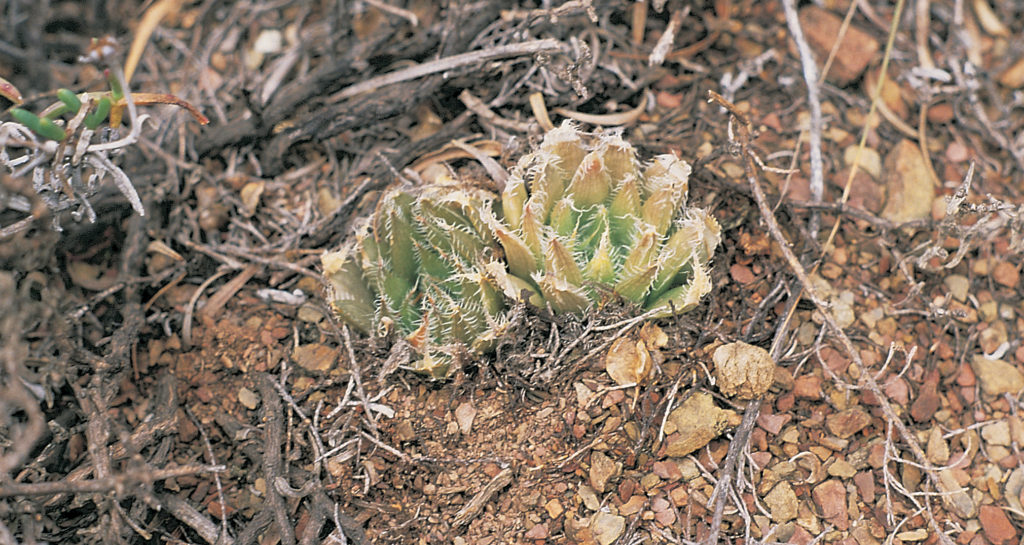
Haworthia mucronata var. mucronata JDV92/50 Perdekop. Here, as at most localities other than the type, the plants have spines on leaf margins and keels.
b. var. habdomadis (V.Poelln.) Bayer comb.nov.
H. habdomadis V.Poelln., Desert.Pl.Life 11:88(1938). Scott :106(1985). H. inconfluens var. habdomadis (V.Poelln.) Bayer :121 (1976). H. habdomadis var. habdomadis (V.Poelln) Bayer, Natn.Cact.Succ.J 32:18(1977). Bayer :41(1982). Type: Cape, Seweweekspoort, A.J. Joubert in Stellenbosch 7692. Not preserved. Neotype (B&M): Seweweekspoort , Barker & Lewis in NBG2764/32 (BOL).
habdomadis: referring to Sevenweekspoort.
1982 – Haworthia habdomadis is a species of the Little Karoo and it extends from Anysberg in the west to as far as Uniondale in the east. Three varieties are recognised as in H. unicolor and these two species have a puzzling relationship. Apart from a locality south of Vanwyksdorp, they are not known to occur together. H. habdomadis var. habdomadis is an element occurring in the sandstone mountains between Sevenweekspoort and just west of Ladismith. The var. inconfluens is more opaque and is usually spineless. This variety occurs in a form at Anysberg barely distinguishable from H. cymbiformis var. transiens, in that it has the same rounded leaf tips. The var. morrisiae is generally a brilliant green colour and occurs in the Oudtshoorn/Volmoed areas. However, it also occurs at Prince Albert and at Van Wyksdorp. It has both pointed and unpointed leaf forms and the distribution does not seem to strictly complement that of the var. inconfluens. Furthermore the form at Van Wyksdorp has the purple tinges associated with H. unicolor var. venteri. The form at Van Wyksdorp has the characteristic leaf shape of H. unicolor var. venteri with the same well‑defined keel and terminal bristle, and at this locality it grows practically in conjunction with that species. The two species flower simultaneously and there do not seem to be significant differences in the flowers. The presence of H. habdomadis var. inconfluens north of Uniondale needs confirmation of identification.
1999 – The circumscription here narrows this variety down to the sandstone forms with a more compact translucent rosette. Although also known from just west of Ladismith, very little further information regarding its distribution is available. Spined forms of this nature are known north of Seweweekspoort and also east of De Rust and presumed to be the var. inconfluens. The recurrence of such soft, short leaved forms north of Montagu is surprising and perhaps re-enforces the perception of ecological adaptation, in this case to low-nutrient sandstone. If this is the case, similar forms should occur on the south facing rocks of the Touwsberg, Anysberg and Warmwaterberg.
Distribution: 3321 (Ladismith): Dwarsrivier (-AC), Bayer 1618 (NBG); Swartbergkloof (-AC), Joubert 182 (BOL); Seweweekspoort (‑AD), H. Hall in NBG69371, Hall 2199 (PRE); Smith 7524 (NBG), Malherbe in NBG654/41, Compton & Lamb in NBG2340/27 (BOL), Barker & Lewis in NBG2764/32 (BOL); Lower Seweweekspoort (-AD), Smith 6991 (NBG).

Haworthia mucronata var. habdomadis JDV97/120 Seweweekspoort. The leaves are shorter and broader than in the typical variety or the var. inconfluens. 
Haworthia mucronata var. habdomadis JDV97/120 Seweweekspoort. There are several sandstone mountain ridges in the Little Karoo, and where H. mucronata or H. arachnoidea occur on them, they occur as smaller, softer variants.
c. var. inconfluens (V.Poelln.) Bayer comb.nov.
H. altilinea var. limpida fa inconfluens V.Poelln., Feddes Repert.Spec.Nov. 45:169(1938). H. mucronata var. limpida fa inconfluens idem. 49:29(1940). H. inconfluens (V.Poelln) Bayer :121(1976). H. habdomadis var. inconfluens (V.Poelln) Bayer, Natn.Cact.Succ.J 32:18(1977). Bayer :41(1982). Type: Cape, Ladismith waterfall, H. Herre in STE7695. Not preserved. Lectotype (B&M): icon, Triebner 1031 (B): H. bijliana var. joubertii V.Poelln., Cactus J 5:36(1936). idem., Feddes Repert.Spec.Nov. 41:196(1937). H. setata var. bijliana sv joubertii idem. 44:224(1938). H. setata var. joubertii (V.Poelln.) Jacobsen, Hand.Succ.Pl. 2:593(1960). Type: Cape, Ladismith, A.J. Joubert in Triebn. 878. Not preserved. Neotype (designated here): CAPE-3321 (Ladismith): N. Ladismith (-AD), Smith 5734 (NBG).
inconfluens: coming together.
It is not known to what von Poellnitz alluded when he named this form. Presumable he was referring to the lines of the leaves joining towards the leaf-tips, or he may have been alluding to the coming-together of different geographic forms. The var. joubertii was collected north of the town of Ladismith where spined forms of this large variety grow. Just south of the town there is a massive population of spineless plants. This variety is not well-represented in the herbarium although it is known as far afield as Hoekvandieberg and Bellair Dam. Eastward it is known to the Huisriver Pass and again northeast of Calitzdorp. From there it is apparently replaced by the green var. morrisiae. A pale grey-green counterpart is found again from Uniondale eastward and this is probably the route to either H. cymbiformis or to H. cooperi. There is another transformation north of Seweweekspoort, already referred to, which involves H. decipiens and H. lockwoodii. Where previous authors have simply confounded H. bolusii var. blackbeardiana with H. mucronata, these populations would surely have driven them finally to a more realistic appreciation of the actual problems involved.
Distribution: 3320 (Montagu): Montagu (-CA), Dymond in NBG2096/32 (NBG); Knipes Bath (-CA), Smith 3990 (NBG); Dammetjies (-CB), Stayner in KG47/67 (NBG); Jakkalsfontein (-DA), Bayer 4438 (NBG); Anysberg Pass (-DA), Bayer 1986 (NBG), Martin 57 (NBG); Warmwaterberg (-DA), Smith 7310 (NBG), 3321(Ladismith): 8km W. Ladismith (-AC), (NBG); Dwarsrivier (-AC), Bayer in KG567/71 (NBG); N. Ladismith (-AD), Smith 5734 (NBG); Ladismith (-AD), Pole-Evans in PRE34908, Malherbe in NBG587/40; Die Berg (-BC), Bayer 159 (NBG); Huis River Pass (-BC), Hardy 320 (PRE), Smith 6887 (NBG); Boerbonefontein (-CA), Laidler 361 (NBG); Noukloof (-CA), Laidler 84 (NBG); 4,5 km south of Ladismith(‑CA), Smith 5503, 5730, 5731 (NBG), Bayer 1628, in KG 590/71 (NBG); 9km SW. Ladismith (-CA). 3322 (Oudtshoorn): Schoemanspoort (-AD), Taylor (BOL).
Inadequately located: Calitzdorp, Blackburn (BOL).

Haworthia mucronata var. inconfluens JDV91/97 south of Langsburg. The plants are normally a paler green with more turgid leaves than the typical variety, and without spines too. 
Haworthia mucronata var. inconfluens JDV89/56 Prinsberg, western Little Karoo. The similarity of the varieties stresses the difficulty of circumscribing them even geographically. 
Haworthia mucronata var. inconfluens JDV86/102 south of the Ladismith. In some populations the plants are more spinose and the historic confusion with H. bolusii var. blackbeardiana is quite justified. 
Haworthia mucronata var. inconfluens JDV91/74 east of Rooinek Pass in the Witteberg. Here the plants may have spinescent leaf margins and somewhat resemble H. decipiens.
d. var. morrisiae V.Poelln.,
Feddes Repert.Spec.Nov. 49:29(1940). Scott :83(1982). H. altilinea var. morrisiae V.Poelln., Feddes Repert.Spec.Nov. 45:168(1938). H inconfluens var. morrisiae (V.Poelln.) Bayer :121(1976). H. habdomadis var. morrisiae (V.Poelln.) Bayer, Natn.Cact.Succ.J 32:18(1977). Bayer :41(1982). Type: Cape, Oudtshoorn and Calitzdorp, Mrs Morris in Long 484. Not preserved. Lectotype (B&M): icon (B).
morrisiae: for Mrs G. Morris.
This is a bright, almost emerald-green, variety from around Oudtshoorn and Calitzdorp. It is known westward to south of Vanwyksdorp. Greenish forms of the species also occur further west at Anysberg Pass and from southwest of the Anysberg.
Distribution: 3320 (Montagu): Touwsfontein (-CB), Bayer 5296 (NBG). 3321 (Ladismith): W. Vanwyksdorp (-CB), Bayer in KG568/71 (NBG); Bergplaas (-BC), Bayer in KG323/70 (NBG); Warmbron (-DB), Bayer 1621 (NBG). 3322 (Oudtshoorn): between Oudtshoorn and Mossel Bay (‑CA), J. Dekenah 197 (NBG); Rooikrans (-CA), Van Niekerk 521 (BOL); Volmoed (-CA), Bayer in KG109/74 (NBG); SW. Oudtshoorn (-CA), Smith 5782 (NBG), Taylor 11776 (PRE); Rooikoppies (-CB), Schnettler in KG334/71 (NBG); Hazenjacht (-CB), Bayer in KG120/71 (NBG); Kamanassie Dam (-CB), Bayer in KG151/72 (NBG); 8km S. Oudtshoorn (-CA), Bayer 2099 (NBG).
Inadequately located: Oudtshoorn, Taylor in NBG981/28 (BOL), Vlakteplaas, Frey (BOL).

Haworthia mucronata var. morrisiae JDV94/44 southeast of Vanwyksdorp. In the area it grows in close association with H. arachnoidea var. nigricans. 
Haworthia mucronata var. morrisiae KG90/60 west of Oudtshoorn. The chestnut brown leaf tips are characteristic.
e. var. rycroftiana Bayer Bayer, JS.Afr. Bot. 47:795(1981). Bayer :54(1975). Type: CAPE‑3321 (Ladismith): Gouritz River between Van Wyksdorp and Herbertsdale (‑DC), Bayer 1701 (NBG).
1982 – The relationships of this species ( ie. H. rycroftiana) are enigmatic. The locality in the Gouritz Valley supports the view that it is related to the H. turgida complex, especially in view of the reported occurrence of the latter species northwest of Calitzdorp. However, the general facies of the plant and its occurrence north of the Langeberg mountains suggest a more probable affinity with H. unicolor or H. habdomadis. H. unicolor is known at its nearest 10 km south of Van Wyksdorp where is grows with H. habdomadis var morrisiae. H. rycroftiana is distinguished from both of these by its more ovate and turgid leaves. It occurs at its only known locality on a steep slope where it is clump‑forming ‑ also reminiscent of H. turgida. The locality and appearance of the plants suggests that this species is a link between the species of the South‑western Cape and the Little Karoo. This particular area between Van Wyksdorp and Zebra, south of Oudtshoorn is entirely unknown as far as Haworthia is concerned and the middle Gouritz valley is also largely unexplored. (P.V. Bruyns has since collected from two populations in this latter area, which are patently the same species).
1999 – Cognizance must be taken of H. integra V. Poelln. as discussed and explored by Scott. This also helps to explain a population which has been distributed as a glabrous variant of var. habdomadis which occurs within the Gamkapoort. References to H. turgida in the 1982 seem to be quite erroneous because that species does not have the translucent margins and keels to the leaves. It also is not known north of the Langeberg mountains as suspected from records. Also around Calitzdorp, var. integra may include spined forms. There is, and will be, probable difficulty in separating these spined forms from H. arachnoidea var. nigricans and more attention to this problem is required.
Distribution: 3321 (Ladismith): 23km E. Ladismith (-AC), Bayer in KG77/71 (NBG); Kruisrivier (-BD), Stayner in KG857/60 (NBG); Vensterkrans, Algerynskraal (-CA), Laidler 376 (NBG); Muiskraal (-CC), Chisholm in NBG774/38 (NBG); Gamka East (-DA), Blackburn (BOL); On Gamka East road (-DA), Scott 1050 (PRE); Danielskraal (-DA), Bruyns 2219 (NBG); Waterkloof (-DA), Bruyns 2231 (NBG); Badspoort (-DB), Bruyns 3724 (BOL); Gouritz River between Van Wyksdorp and Herbertsdale (‑DC), Bayer 1701 (NBG). 3322 (Oudtshoorn): N. Oudtshoorn (-AC), Smith 5089, 5783 (NBG); Schoemanspoort (-AD), Smith 5085 (NBG), Bayer 171 (NBG).
Inadequately located: Barrydale, Venter 8 (BOL), Bolus in NBD696/35 (BOL); Riversdale, Ferguson (BOL); Riethuiskraal, Ferguson (BOL); Oudtshoorn, Peers (BOL).

Haworthia mucronata var. rycroftiana JDV87/98 Waterkloof, Rietvlei. The leaves are smooth and thicker than in the typical variety. The acuminate leaf tip is also shorter. 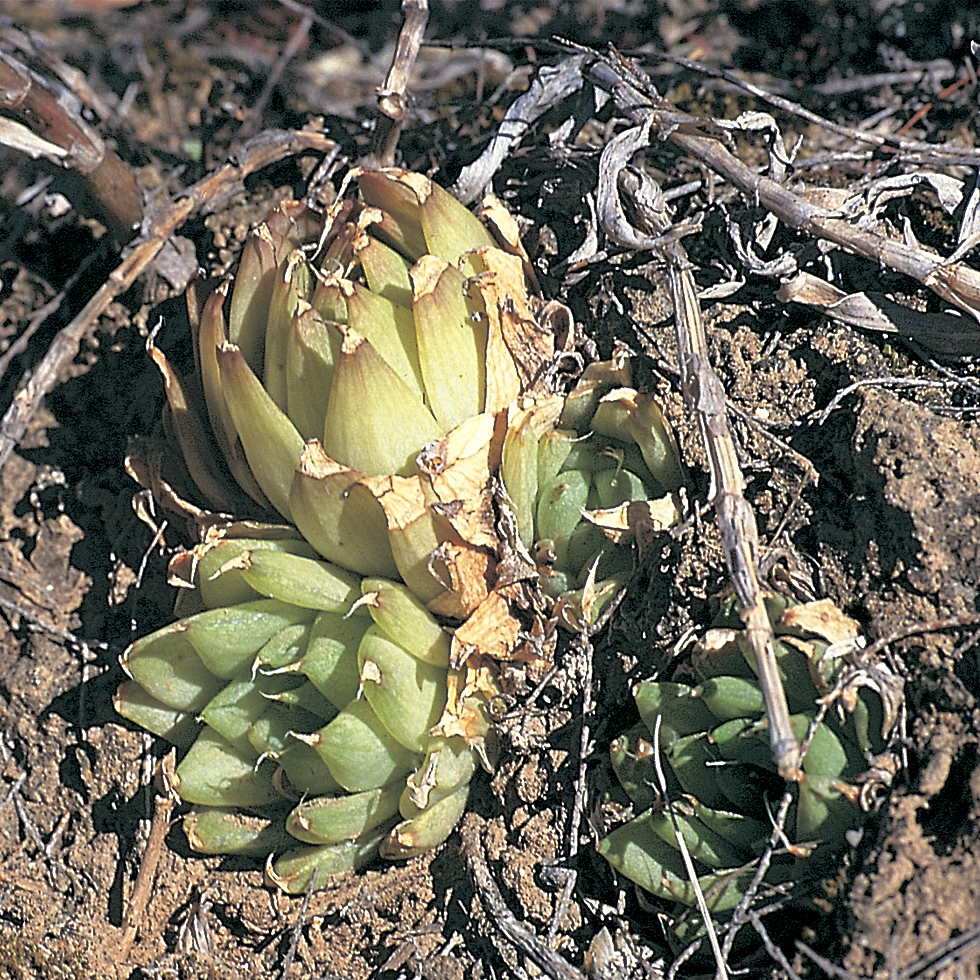
Haworthia mucronata var. rycroftiana JDV90/62 Gouritz River Gorge, type locality for this variety. 
Haworthia mucronata var. rycroftiana JDV91/6 Gamkakloof. A smaller form with shortis leaves and resembling a glabrous form of var. habdomadis. 
Haworthia mucronata var. rycroftiana JDV92/57 Gamka East. This is one of the several populations where H. mucronata and H. arachnoidea are confounded.






